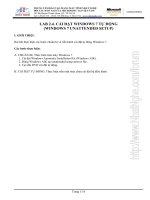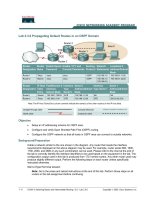sedimentary petrology lab 2
Bạn đang xem bản rút gọn của tài liệu. Xem và tải ngay bản đầy đủ của tài liệu tại đây (2.23 MB, 28 trang )
Sedimentary Petrology
GEO 333
Lab (2)
Basic Classification
2009
Mansour Al-Hashim
Preview of Lab 1
Introduction
Main minerals of sedimentary rocks
Objectives of Lab 2
Classification in general
Classification of sedimentary rocks
Clastic sedimentary rocks
Chemical and biochemical sedimentary rocks
Fundamental constituents of sedimentary rocks
Introduction to Classification
1.
A classification of rocks represents a theory of how these rocks
were formed, and how they relate to each other.
2.
Many classifications have been proposed for sedimentary rocks.
3.
Since 1950, more than 50 classifications of sandstones alone
have been proposed.
4.
No one classification is fully satisfactory.
5.
The type of classification depends on the purpose of the study
being conducted.
A Good Classification
1.
Should be as inclusive as possible.
2.
Includes as much variety as possible.
3.
Leaves only few or no orphan rocks.
4.
Dose not contain any internal contradictions.
We will see several classification systems, ranging
from basic to sophisticated.
Sedimentary Rock Classification
a)
b)
c)
Sedimentary rocks are generally grouped into
three main categories:
Siliciclastic (clastic) rocks
Chemical rocks
Biochemical rocks
Simple Classification of Sedimentary Rocks
Modified from Boggs (1992)
Clastic (terrigenous/detrital)
Sedimentary Rocks
1.
Derived from pre-existing rocks.
2.
Composed of physically derived components.
3.
Sometimes referred to as extrabasinal.
4.
Grains are mechanically durable and chemically stable.
5.
Clasts are made of quartz, feldspar, muscovite, clay minerals,
and rock fragments.
6.
Silica (SiO2) is the major component.
7.
Classified based on texture (grain size).
8.
Examples: breccia, conglomerate, sandstone, siltstone, and
shale.
Basic Classification of Clastic Sedimentary Rocks
Breccia
from geology.com
from geology.com
Conglomerate
Chemical and Biochemical Sedimentary
Rocks
1. Derived from precipitation of dissolved minerals in the
solution.
a)
Direct precipitation from seawater. The result is
Chemical Rocks.
b)
Organism extraction of the dissolved minerals from
the sea. The result is Biochemical Rocks.
2. Classified based on the chemical composition.
3. Examples: limestone, chert, and chalk.
Basic Classification of Chemical and Biochemical
Sedimentary Rocks
Chert
from geology.com
from geology.com
Coquina
Fundamental Constituents of
Sedimentary Rocks
Sediments consist of three components:
A.
Terrigenous components
B.
Allochemical components
C.
Orthochemical components
They may be mixed in almost all proportions.
From Folk (1974)
(A) Terrigenous components
Derived from erosion of areas outside the
depositional basin.
Brought to the basin as solids.
Examples: quartz and feldspar sand, heavy
minerals, clay minerals, and chert and limestone
clasts.
(B) Allochemical components
Greek: “allo” meaning different from normal.
Precipitated directly from solution within the
depositional basin.
Termed “allo” because they have been moved as solids
within the basin.
Examples: broken or intact shells, oolites, calcareous
pellets, or fragments of carbonate sediments.
(C) Orthochemical components
Greek: “ortho” meaning true.
Termed “ortho” because they are produced chemically
within the basin.
Examples: microcrystalline calcite or dolomite ooze,
some evaporites, and cements in sandstones.
Notes
Classes (B) and (C) are referred to as “chemical”
constituents.
Classes (A) and (B) may be termed “fragmental”.
Basic Classification of Sedimentary
Rocks (1)
Sedimentary rocks are divided into five classes based
on proportions of the fundamental components:
1.
T (Terrigenous Rocks)
2.
IA (Impure Allochemical Rocks)
3.
IO (Impure Orthochemical Rocks)
4.
A (Allochemical Rocks)
5.
O (Orthochemical Rocks)
From Folk (1974)
Basic Classification of Sedimentary
Rocks (2)
Terrigenous Rocks (T)
Examples: mudrocks, sandstones, and conglomerates.
Impure Allochemical Rocks (IA)
Examples: very fossiliferous shales; sandy fossiliferous or
oolitic limestones.
Impure Orthochemical Rocks (IO)
Examples: clayey microcrystalline limestones.
Basic Classification of Sedimentary
Rocks (3)
Allochemical Rocks (A)
Examples: fossiliferous, oolitic limestones and dolomites.
Orthochemical Rocks (O)
Examples: limestone, dolomite, anhydrite, and chert.









